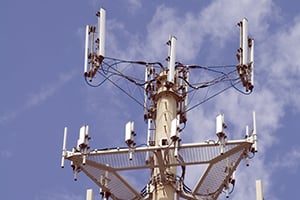6G Market Projected to Grow at a CAGR of 103%
6G is anticipated to assume a crucial role in enhancing the performance and efficiency of telecommunication systems in both industrial and consumer settings. In an era marked by the exponential rise of the Internet of Things (IoT), Industry 4.0,...

These solutions are centered on networks and their applications, boasting low-latency rates and high-speed data transfer techniques, ultimately fueling the expansion of intelligent technologies, such as automation and artificial intelligence, across a spectrum of industries. As per the experts of BIS Research, the 6G market is projected to be valued at $1.58 billion in 2028, and it is expected to grow at a compound annual growth rate (CAGR) of 103.35% and reach $1,293.19 billion by 2035. The expansion of the 6G market can be attributed to a strong emphasis on low-latency networks for specialized applications and the increasing adoption of internet services and edge computing devices, among other factors. The 6G market is driven by several factors. One of these factors is the need for the development of new low-loss materials for advanced networks. Another contributing factor is the increased emphasis of consumers on satellite communication. Additionally, the growing adoption of internet services and edge computing devices plays a significant role in driving the 6G market. Furthermore, the growth of smart technologies, such as gadget-free communication, is a key catalyst in this market's expansion. Companies such as Apple, AT&T, Intel, Nokia, Samsung, and others are prioritizing strategic alliances, cooperative ventures, and acquisitions as part of their efforts to improve their product portfolios and broaden their footprint in the market. Thus, the 6G market is expected to experience substantial growth and transformation due to factors such as the incorporation of holography in communication, the pivotal role of 6G in advancing IoT, blockchain, and artificial intelligence, along with its contribution to UN Sustainable Development Goals and impact on telecommunications. Based on its applications in various industries and enterprises, the 6G market has been primarily categorized into different sectors, including Industry 4.0, smart city and urban development, infrastructure, e-healthcare, autonomous vehicles, and other domains. 6G technology is anticipated to expedite the industrial revolution and achieve comprehensive digitalization, capitalizing on its advantages over 5G technology. For instance, in 2022, the European Union announced a $22.36 billion (€20 billion) investment in 6G research and development. 6G can be used to create a more efficient and interconnected transportation system. It can be used to improve the efficiency and reliability of power grids. For example, 6G-enabled sensors could be used to monitor power usage and identify potential problems, such as power outages. In the healthcare sector, 6G could be used to provide telehealth services, such as video consultations and remote monitoring, to improve access to healthcare. Moreover, 6G could be used to connect wearable devices, such as fitness trackers and heart monitors. This would help to collect data on a patient’s health and make it easier for doctors to monitor the progress. A study by the McKinsey Global Institute found that 6G could improve the quality of life for millions of people with chronic conditions. It acknowledges the significance and interconnectedness of the physical and psychological aspects. The forthcoming 6G telecommunications standard is forecasted to incorporate key features such as ultra-low latency to minimize delays and high data transmission rates, which would be indispensable for achieving full automation in industrial settings. Furthermore, this technology is poised to harness the terahertz communication frequency bandwidth, facilitating data transmission in less congested bandwidths. The adaptability of communication systems to cater to individual preferences has effectively enticed numerous new consumers. These communication systems have undergone substantial development and evolution, progressing from the initial generation to the sixth-generation telecommunication standard. Communication system infrastructures can be further categorized into fixed communication systems and wireless communication systems. Contemporary smartphones include a functionality called a portable hotspot, enabling users to utilize their phone's cellular data by converting their phones into portable modems. This portable hotspot enables laptops and other electronic devices to connect to smartphones for internet access. The 6G market holds a prominent share in various countries of North America, China, Europe, Asia-Pacific, and Japan. According to Dhrubajyoti Narayan, principal analyst at BIS Research, China is indeed expected to dominate the 6G market in the coming years. However, specific technical hurdles, such as the absence of worldwide security protocols and standards for 5G and 6G, along with the rising concerns about data security and privacy risks, could potentially impede the expansion of the 6G market. The anticipated rollout of 6G technology is expected in selected areas of developed countries by 2028, with substantial growth projected across all regions starting from 2030 onward. For more information, see 6G Market - A Global and Regional Analysis by BIS Research. About the Publisher: BIS Research is a global market intelligence, research and advisory company that focuses on emerging technology trends that are likely to disrupt the market. Its team includes industry veterans, experts, and analysts with diverse backgrounds in consulting, investment banking, government, and academia. 6G is anticipated to assume a crucial role in enhancing the performance and efficiency of telecommunication systems in both industrial and consumer settings. In an era marked by the exponential rise of the Internet of Things (IoT), Industry 4.0, and home automation, the demand for cutting-edge network solutions has become an indispensable facet of the telecommunications sector.
6G is anticipated to assume a crucial role in enhancing the performance and efficiency of telecommunication systems in both industrial and consumer settings. In an era marked by the exponential rise of the Internet of Things (IoT), Industry 4.0, and home automation, the demand for cutting-edge network solutions has become an indispensable facet of the telecommunications sector.Industrial Impact of 6G
Impact of 6G on Various Sectors
Communication Infrastructure Projected to Dominate Revenue Generation in the 6G Market
Conclusion

 Kass
Kass 







.jpg)


![How to Accept Payments Online [7 Top Payment Processing Providers]](https://blog.hubspot.com/hubfs/payment%20processing.jpg#keepProtocol)

_3.jpg)


















